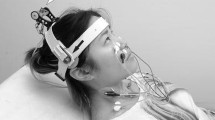Summary
Direct and parametric effects of stretch receptors in the extraocular muscles on abducens nerve activity were investigated in the unanesthetized immobilized frog. Horizontal passive rotations of one eye in the physiological range (±5°) did not elicit responses in the activity of abducens nerve on either side; however, larger rotations or pull of one eye evoked long latency direction-unspecific responses simultaneously in both nerves. When the animal was stimulated vestibulary in the horizontal plane with sinusoidal or constant acceleration, abducens activity was not altered in correlation to passive eye movements in the physiological range. Similarly, the activity of either nerve evoked by simultaneous or preceding optokinetic stimulation of one eye with constant pattern velocity was not modified by passive rotation of the contralateral eye.
Similar content being viewed by others
References
Abrahams VC, Rose PK (1975) Projections of extraocular, neck muscle and retinal afferents to superior colliculus in the cat: their connections to cells of origin of tectospinal tract. J Neurophysiol 38: 10–18
Allum JHJ, Graf W (1977) Time constants of vestibular nuclei neurons in the goldfish: a model with ocular proprioception. Biol Cybern 28: 95–99
Ashton JA, Boddy A, Donaldson IML (1984) Input from proprioceptors in the extrinsic ocular muscles to the vestibular nuclei in the giant toad, Bufo marinus. Exp Brain Res 53: 409–419
Bach-y-Rita P (1972) Extraocular muscle inhibitory stretch reflex during active contraction. Arch Ital Biol 110: 1–15
Bach-y-Rita P, Ito F (1966) Properties of stretch receptors in cat extraocular muscles. J Physiol (Lond) 186: 663–688
Baker R, Precht W, Llinás R (1972) Mossy and climbing fiber projections of extraocular muscle afferents to the cerebellum. Brain Res 38: 440–445
Cochran SL, Dieringer N, Precht W (1984) Basic optokinetic-ocular reflex pathways in the frog. J Neurosci 4: 43–57
Daunicht WJ (1983) Proprioception in extraocular muscles of the rat. Brain Res 278: 291–294
Daunicht WJ (1984) Lack of response of oculomotor units to eye muscle stretch in alert rats. Neurosci Lett 18: S231
Dieringer N, Daunicht WJ (1986) Image fading — a problem for frogs? Naturwissenschaften 73: 330–331
Dieringer N, Precht W (1982) Compensatory head and eye movements in the frog and their contribution to stabilization of gaze. Exp Brain Res 47: 394–406
Dieringer N, Precht W (1986) Functional organization of eye velocity and eye position signals in abducens motoneurons of the frog. J Comp Physiol 158: 179–194
Keller EL, Robinson DA (1971) Absence of a stretch reflex in extraocular muscles of the monkey. J Neurophysiol 34: 908–919
Ludvigh E (1952) Control of ocular movements and visual interpretation of environment. Arch Ophthalmol 48: 442–448
Maekawa K, Kimura M (1980) Mossy fiber projections to the cerebellar flocculus from extraocular muscle afferents. Brain Res 191: 313–325
Maier A, DeSantis M, Eldred E (1974) The occurrence of muscle spindles in extraocular muscles of various vertebrates. J Morph 143: 397–408
Meyer DL, Bonnemann D, Schaefer KP (1973) Equalization of asymmetries of tonus in the optomotor system of rabbits. A study on oculomotor neurons. Exp Brain Res 18: 505–511
Pettorossi VE, Filippi GM (1981) Muscle spindle autogenic inhibition in the extraocular muscles of lamb. Arch Ital Biol 119: 179–194
Sabussow GH, Maslow AP, Burnaschewa DW (1964) Vergleichend-morphologische und einige histochemische Beobachtungen an besonderen Rezeptoren der Augenmuskeln bei Wirbeltieren. Anat Anz 114: 27–37
Schaaf P (1979) Muskelspindeln in den äußeren Augenmuskeln der Vertebraten. In: Drischel H, Kirmse W (eds) Das okulomotorische System, physiologische und klinische Aspekte. VEB Georg Thieme, Leipzig, pp 173–180
Székely G, Antal N, Göres Th (1980) Direct dorsal root projection onto the cerebellum in the frog. Neurosci Lett 19: 161–165
Taylor A (1965) The role of sensory feedback in the vestibulo-ocular response in cats. J Physiol (Lond) 179: 76P-77P
Author information
Authors and Affiliations
Rights and permissions
About this article
Cite this article
Daunicht, W.J., Dieringer, N. Extraocular proprioceptive signals affect ocular motor activity neither directly nor parametrically in the presence of optokinetic or vestibular stimulation in the frog. Exp Brain Res 64, 535–540 (1986). https://doi.org/10.1007/BF00340491
Received:
Accepted:
Issue Date:
DOI: https://doi.org/10.1007/BF00340491




